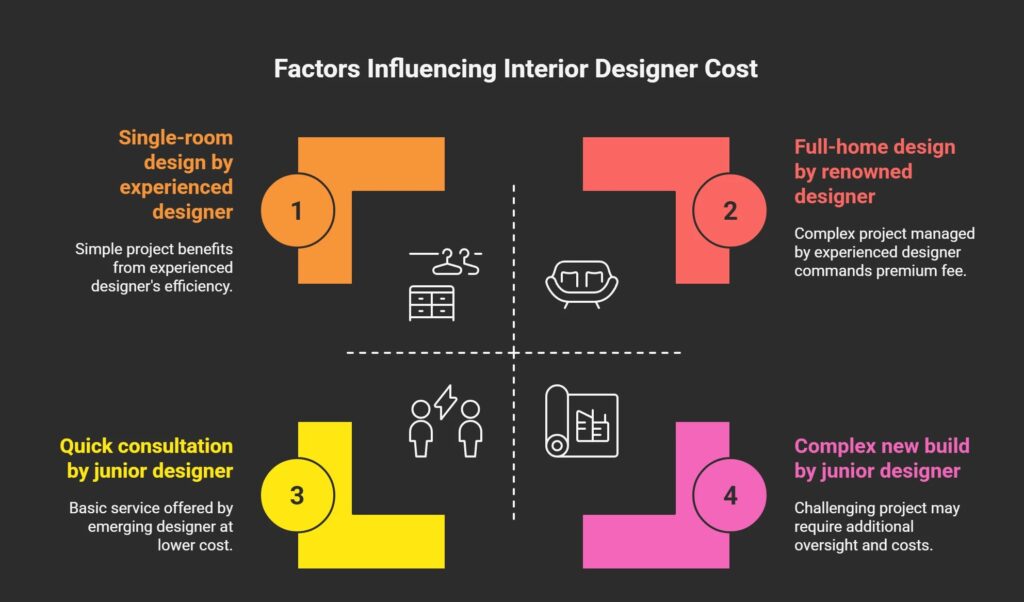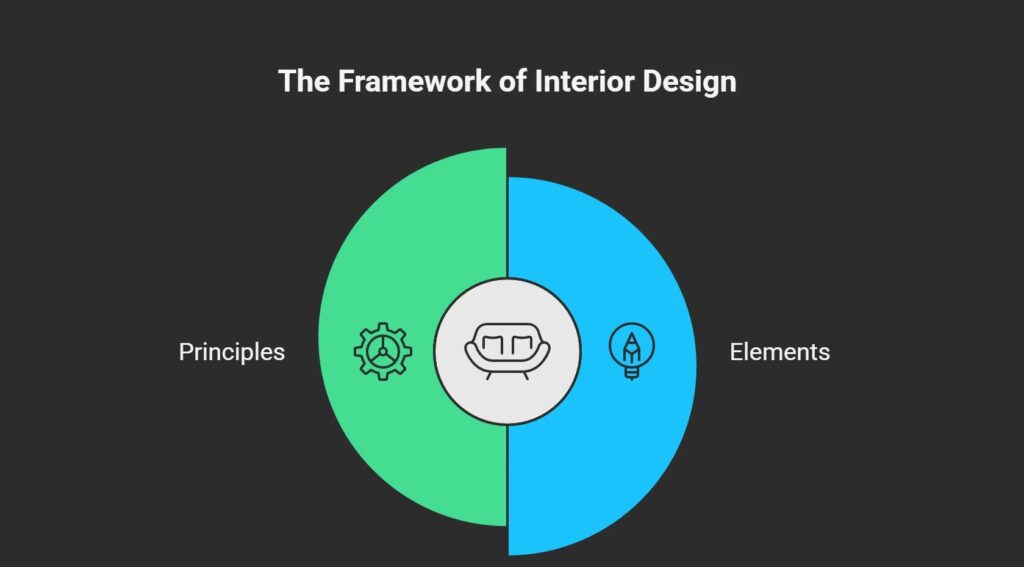If you’ve ever dreamt of walking into a space that feels tailor-made for you, a space that’s not just beautiful, but perfectly functional, you’ve likely considered hiring an interior designer. It’s the smart step toward turning a house into a home, or a commercial space into a business advantage.
For many, the cost of home interior design services is shrouded in mystery, leading to the misconception that it’s only for the ultra-wealthy. The truth is, the price of professional design is less about a single fixed number and more about a flexible, multi-tiered structure that can be customized to fit nearly any budget, from a quick, affordable interior design consultation to a full-scale architectural and interior design services renovation.
At MK Professional Services, we believe that an informed client is a happy client. This comprehensive guide will demystify interior design pricing, break down the most common fee structures, and show you exactly how to budget for the transformation you deserve.

The Core Factors That Determine Interior Designer Cost
Before diving into dollar amounts, it’s essential to understand that an interior designer’s fee is influenced by four primary factors:
Scope of the Project: Are you designing a single powder room, a full-home refresh, or coordinating a complex new build that requires both architectural and interior design services? The larger and more complex the work, the higher the total fee. For example, a single-room design might cost a few thousand dollars in design fees, while a full-home project could range from
- $15,000
- $15,000
to over
- $100,000
- $100,000
- excluding furniture.
- Level of Service (The How Much Involvement): A quick two-hour consultation costs far less than a residential interior design services package that includes concept-to-installation project management. Full-service projects, which cover everything from design to contractor oversight, naturally command a premium.
- Location (The Where): Design fees are heavily market-dependent. A designer operating in a major metropolitan area like New York City, where the cost of living and overhead are significantly higher, will charge more. If you’re looking for interior design services in New York, expect to be at the higher end of the national averages.
- Designer’s Experience & Reputation (The Who): A renowned, high-end principal designer with a decade of experience will charge more than an emerging junior designer. Experience translates to efficiency, trade access, and fewer costly mistakes.
Breakdown of Interior Designer Fee Structures
Interior designers utilize several standard pricing models. The one you choose often depends on the size and complexity of your project and your comfort level with a fixed price versus a variable cost.
1. Hourly Rate (The Consultant Model)
This model is straightforward: you pay for the designer’s time. It’s often best for small projects, initial consultations, or when you only need help with specific tasks like selecting paint colors or reviewing architectural plans.
| Designer Level | Typical Hourly Rate |
| Junior/Emerging | $50 to $100 per hour |
| Standard/Mid-Level | $100 to $200 per hour |
| High-End/Principal | $250 to over $500 per hour |
- Pros: Flexible, ideal for small scopes, and transparent about time spent.
- Cons: Can lead to unpredictable total costs if the project scope expands, which is why a detailed contract outlining estimated hours is crucial.
2. Flat Fee (The Fixed Price Model)
A flat fee involves a single, agreed-upon price for a defined scope of work (e.g., “designing the master bedroom”). This model provides budget certainty, regardless of how many hours the project actually takes.
| Project Scope | Typical Flat Fee Range (Design Fee Only) |
| Single Room Refresh | $1,000 to $5,000 |
| Complex Single Room/Renovation | $5,000 to $15,000+ |
| Full-Home Design | $20,000 to $150,000+ |
- Pros: Total price is locked in upfront, which simplifies budgeting.
- Cons: Any changes to the original scope (known as “scope creep”) will result in additional fees.
3. Percentage of Project Cost (The Full-Service Model)
This is a common model for large-scale architectural and interior design services or high-end, full-service residential interior design services projects that include substantial construction or renovation. The designer’s fee is a percentage of the total project budget, which includes construction, materials, and furnishings.
- Design Fees: Typically 10% to 20% of the total construction cost for new builds or major remodels.
- Total Project Fee: For example, on a
- $500,000
- $500,000
- construction project, a 15% design fee would be
- $75,000
- $75,000.
4. Markup/Commission (The Procurement Model)
In this model, the designer charges a fee (a markup) on all the furniture, materials, and accessories they purchase for you. They often buy at a discounted “trade price” and then sell the items to you at a retail price, or a price that includes a set markup (often 10% to 40%) above their cost.
- Benefit: This approach can often offset or reduce the hourly or flat design fee, as the designer earns income through procurement. The client often still pays less than retail, while gaining access to “to-the-trade-only” goods.
How to Access Budget Interior Design Services
The good news is that professional design is more accessible than ever, thanks to technology and specialized service models. If your goal is budget interior design services or affordable interior design services, focus on these alternatives:
1. E-Design (The Best Online Interior Design Services)
E-Design is a modern, remote service where the entire project is managed virtually. The client provides measurements and photos, and the designer delivers a complete package, including a floor plan, mood board, 3D renderings, and a clickable shopping list with retail links.
- Cost: E-Design packages typically range from $159 to $2,099 per room on a flat-fee basis.
- Why it’s Affordable: The cost is dramatically lower because the designer saves time by eliminating site visits, ordering, and installation oversight. The client executes the design plan themselves, making it perfect for the DIY enthusiast who needs a professional plan. This is often the route to finding the best online interior design services for your budget.
2. Design Consultation Only
Many full-service firms offer an entry-level “Designer-for-a-Day” or consultation package, typically billed at their hourly rate. You can use this time strategically to get professional advice on layouts, material selection, or a tricky design problem without committing to a full project.

What Are the Basics of Interior Design That Justify the Cost?
A designer’s fee pays for much more than just pretty pictures; it pays for the expertise to apply the fundamental principles and elements of design, which is what separates a decorated room from a well-designed space.
A professional’s job is to master the what are the basics of interior design to create harmony and function. These basics are broken down into Elements (the tools) and Principles (the rules):
The 7 Elements of Interior Design
- Space: Balancing positive space (filled) and negative space (empty) for optimal flow.
- Line: Guiding the eye with vertical (stability), horizontal (calm), and dynamic (movement) lines.
- Form: The shape and structure of furniture and architectural features.
- Light: Natural and artificial light to set the mood and highlight focal points.
- Color: Influencing emotion, perception of size, and mood.
- Texture: Adding depth and interest (e.g., mixing a rough brick with a smooth textile).
- Pattern: Creating life and visual rhythm through repetition.
The 7 Principles of Interior Design
- Balance: Creating visual equilibrium, whether symmetrical (formal), asymmetrical (informal), or radial.
- Unity & Harmony: Ensuring all elements (furnishings, color, style) work together as a cohesive whole.
- Rhythm: Creating flow and continuity through the repetition of elements like color or line.
- Proportion & Scale: Making sure the size of furniture and decor is appropriate for the room and for each other.
- Emphasis: Using a focal point (e.g., an architectural feature or artwork) to draw attention.
- Contrast: Mixing elements (e.g., light vs. dark, rough vs. smooth) to keep the space interesting.
- Details: The finishing touches—trim, hardware, and accessories—that complete the design.
By hiring an expert, you are paying them to apply this intricate framework to your project, ensuring your investment results in a space that is aesthetically stunning and structurally sound.
Conclusion: Setting a Realistic Budget
The cost of an interior designer is a variable, not a fixed rate. It’s an investment that can save you time, prevent costly mistakes, and ultimately increase the value and enjoyment of your space.
To begin your design journey with confidence, you must first define your scope and your budget. Whether you need a low-cost E-Design plan to kickstart your DIY project or a full residential interior design services team to manage a high-end renovation, there is a pricing model that fits your financial plan.



Leave a comment